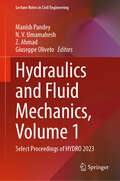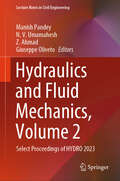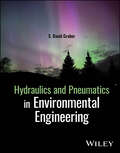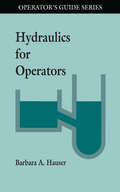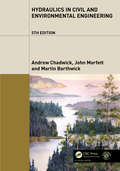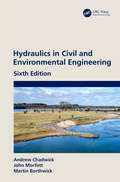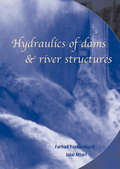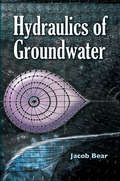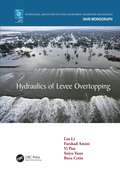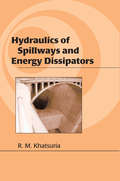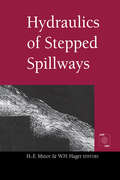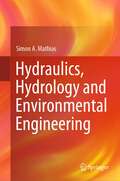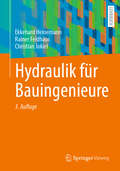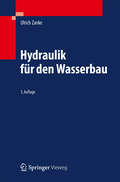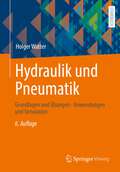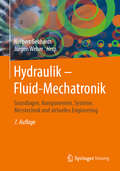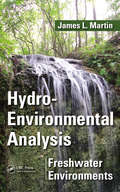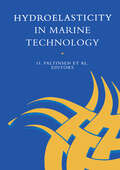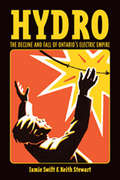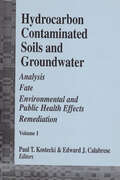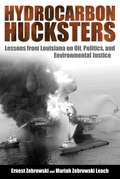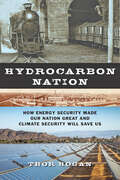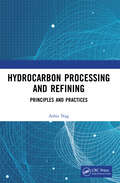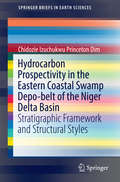- Table View
- List View
Hydraulics and Fluid Mechanics, Volume 1: Select Proceedings of HYDRO 2023 (Lecture Notes in Civil Engineering #547)
by Manish Pandey Giuseppe Oliveto N. V. Umamahesh Z. AhmadThis book comprises the proceedings of the 28th International Conference on Hydraulics, Water Resources, River and Coastal Engineering (HYDRO 2023) focusing on broad spectrum of emerging opportunities and challenges in the field of hydraulics and fluid mechanics. It covers a range of topics, including, but not limited to, experimental and computational fluid mechanics, sediment dynamics, environmental impact assessment of water resources projects, environmental flows, pollutant transport, etc. Presenting recent advances in the form of illustrations, tables, and text, it offers readers insights for their own research. In addition, the book addresses fundamental concepts and studies in the field of flood forecasting and hydraulic structures, making it a valuable resource for both beginners and researchers wanting to further their understanding of hydraulics, water resources and coastal engineering.
Hydraulics and Fluid Mechanics, Volume 2: Select Proceedings of HYDRO 2023 (Lecture Notes in Civil Engineering #560)
by Manish Pandey Giuseppe Oliveto N. V. Umamahesh Z. AhmadThis book comprises the proceedings of the 28th International Conference on Hydraulics, Water Resources, River and Coastal Engineering (HYDRO 2023) focusing on broad spectrum of emerging opportunities and challenges in the field of hydraulics and fluid mechanics. It covers a range of topics, including, but not limited to, experimental and computational fluid mechanics, sediment dynamics, environmental impact assessment of water resources projects, environmental flows, pollutant transport, etc. Presenting recent advances in the form of illustrations, tables, and text, it offers readers insights for their own research. In addition, the book addresses fundamental concepts and studies in the field of flood forecasting and hydraulic structures, making it a valuable resource for both beginners and researchers wanting to further their understanding of hydraulics, water resources and coastal engineering.
Hydraulics and Pneumatics in Environmental Engineering
by S. David GraberBring the tools of hydraulics and pneumatics to bear on key environmental challenges Hydraulics and pneumatics are essential tools in environmental engineering. Any area of engineering which deals with harnessing, managing, and controlling fluid and flow will find hydraulics and pneumatics indispensable, and environmental engineering is no exception. These two subjects, however, are rarely integrated in standard teaching and research resources, and there exists an urgent need for a work which brings them together. Hydraulics and Pneumatics in Environmental Engineering meets this need with a thorough, accessible overview of this vital subject. Written for advanced environmental engineering students and assuming a sound undergraduate background in fluid mechanics, this book otherwise provides everything needed to bring hydraulic and pneumatic tools and principles to bear on environmental engineering problems. With civil and environmental engineering only becoming more essential as communities grow and the challenges of climate change mount, the next generation of engineers will be amply served by this text. Hydraulics and Pneumatics in Environmental Engineering readers will also find: An emphasis on practical applications, often under-valued in civil engineering courses Detailed discussion of topics including Navier-Stokes, G-Value, incompressible flow, and many more Diagrams and figures throughout to illustrate key points Hydraulics and Pneumatics in Environmental Engineering is ideal for graduate and advanced undergraduate students in civil and environmental engineering, as well as for researchers and practicing engineers in need of a reference.
Hydraulics for Operators
by Barbara HauserThis important new reference addresses the principles and calculations dealing with the hydraulics of water systems. Hydraulics for Operators includes what is necessary for a basic understanding of water and wastewater utility operations, and it emphasizes practical applications of these principles. This practical reference covers a wide variety of important subjects such as mass density and flow, pressure, open channel flow, pumping, friction loss, and flow measurement.Hydraulics for Operators is loaded with graphics, and sample exercises are included to ensure this new book is an easily understood reference. It is a must for your operator library.
Hydraulics in Civil and Environmental Engineering
by Andrew Chadwick John Morfett Martin BorthwickNow in its fifth edition, Hydraulics in Civil and Environmental Engineering combines thorough coverage of the basic principles of civil engineering hydraulics with wide-ranging treatment of practical, real-world applications. This classic text is carefully structured into two parts to address principles before moving on to more advanced topics. The first part focuses on fundamentals, including hydrostatics, hydrodynamics, pipe and open channel flow, wave theory, physical modeling, hydrology, and sediment transport. The second part illustrates the engineering applications of these fundamental principles to pipeline system design; hydraulic structures; and river, canal, and coastal engineering—including up-to-date environmental implications. A chapter on computational hydraulics demonstrates the application of computational simulation techniques to modern design in a variety of contexts. What’s New in This Edition Substantive revisions of the chapters on hydraulic machines, flood hydrology, and computational modeling New material added to the chapters on hydrostatics, principles of fluid flow, behavior of real fluids, open channel flow, pressure surge in pipelines, wave theory, sediment transport, river engineering, and coastal engineering The latest recommendations on climate change predictions, impacts, and adaptation measures Updated references Hydraulics in Civil and Environmental Engineering, Fifth Edition is an essential resource for students and practitioners of civil, environmental, and public health engineering and associated disciplines. It is comprehensive, fully illustrated, and contains many worked examples. Spreadsheets and useful links to other web pages are available on an accompanying website, and a solutions manual is available to lecturers.
Hydraulics in Civil and Environmental Engineering
by Andrew Chadwick John Morfett Martin BorthwickThis classic text, now in its sixth edition, combines a thorough coverage of the basic principles of civil engineering hydraulics with a wide-ranging treatment of practical, real-world applications. It now includes a powerful online resource with worked solutions for chapter problems and solution spreadsheets for more complex problems that may be used as templates for similar issues. Hydraulics in Civil and Environmental Engineering is structured into two parts to deal with principles and more advanced topics. The first part focuses on fundamentals, such as hydrostatics, hydrodynamics, pipe and open channel flow, wave theory, physical modelling, hydrology and sediment transport. The second part illustrates engineering applications of these principles to pipeline system design, hydraulic structures, river and coastal engineering, including up-to-date environmental implications, as well as a chapter on computational modelling, illustrating the application of computational simulation techniques to modern design, in a variety of contexts. New material and additional problems for solution have been added to the chapters on hydrostatics, pipe flow and dimensional analysis. The hydrology chapter has been revised to reflect updated UK flood estimation methods, data and software. The recommendations regarding the assessment of uncertainty, climate change predictions, impacts and adaptation measures have been updated, as has the guidance on the application of computational simulation techniques to river flood modelling. Andrew Chadwick is an honorary professor of coastal engineering and the former associate director of the Marine Institute at the University of Plymouth, UK. John Morfett was the head of hydraulics research and taught at the University of Brighton, UK. Martin Borthwick is a consultant hydrologist, formerly a flood hydrology advisor at the UK’s Environment Agency, and previously an associate professor at the University of Plymouth, UK.
Hydraulics of Dams and River Structures: Proceedings of the International Conference, Tehran, Iran, 26-28 April 2004
by Farhad Yazdandoost Jalal AttariThis book comprises the papers of the International Conference on Hydraulics of Dams and Rivers Structures, held in Tehran, 26-28 April 2004. The topics covered include air-water flows, intakes and outlets, hydrodynamic forces, energy dissipators, stepped spillways, scouring and sedimentation around structures, numerical approaches in river hydrody
Hydraulics of Groundwater
by Jacob BearThis text explores the laws and equations that govern the flow and storage of groundwater in aquifers. It provides groundwater hydrologists, as well as engineers and planners who deal with the development and management of groundwater resources, with all the necessary tools to forecast the behavior of a regional aquifer system.Following an introduction to the role and management of groundwater in water resource systems, the text examines groundwater balance and motion, mathematical statements of the groundwater forecasting problem, flow in the unsaturated zone, and groundwater quality problems. Additional topics include hydraulics of pumping and recharging wells, fresh and salt water interface in coastal aquifers, modeling of aquifer systems, identification of aquifer parameters, and the use of linear programming in aquifer management. Helpful appendixes and a set of problems corresponding to selected chapters conclude the text.
Hydraulics of Levee Overtopping (IAHR Monographs)
by Yi Pan Lin Li Bora Cetin Farshad Amini Saiyu YuanEarthen levees are extensively used to protect the population and infrastructure from periodic floods and high water due to storm surges. The causes of failure of levees include overtopping, surface erosion, internal erosion, and slope instability. Overtopping may occur during periods of flooding due to insufficient freeboard. The most problematic situation involves the levee being overtopped by both surge and waves when the surge level exceeds the levee crest elevation with accompanying wave overtopping. Overtopping of levees produces fast-flowing, turbulent water velocities on the landward-side slope that can potentially damage the protective grass covering and expose the underlying soil to erosion. If overtopping continues long enough, the erosion may eventually result in loss of levee crest elevation and possibly breaching of the protective structure. Hence, protecting levees from erosion by surge overflow and wave overtopping is necessary to assure a viable and safe levee system. This book presents a cutting-edge approach to understanding overtopping hydraulics under negative free board of earthen levees, and to the study of levee reinforcing methods. Combining soil erosion test, full-scale laboratory overtopping hydraulics test, and numerical modeling for the turbulent overtopping hydraulics. It provides an analysis that integrates the mechanical and hydraulic processes governing levee overtopping occurrences and engineering approaches to reinforce overtopped levees. Topics covered: surge overflow, wave overtopping and their combination, full-scale hydraulic tests, erosion tests, overtopping hydraulics, overtopping discharge, and turbulent analysis. This is an invaluable resource for graduate students and researchers working on levee design, water resource engineering, hydraulic engineering, and coastal engineering, and for professionals in the field of civil and environmental engineering, and natural hazard analysis.
Hydraulics of Spillways and Energy Dissipators (Civil And Environmental Engineering Ser.)
by Rajnikant M. KhatsuriaAn unsurpassed treatise on the state-of-the-science in the research and design of spillways and energy dissipators, Hydraulics of Spillways and Energy Dissipators compiles a vast amount of information and advancements from recent conferences and congresses devoted to the subject. It highlights developments in theory and practice and emphasizing top
Hydraulics of Stepped Spillways: Proceedings of the International Workshop on Hydraulics of Stepped Spillways, Zurich, Switzerland, 22-24 March 2000
by H. E. MinorThis book provides a discussion of the latest research pertaining to the hydraulic design of spilways and to hydraulic engineering in general. It comprises the papers of a workshop organized to bring together engineers and scientists from around the world for the exchange of ideas on water flow over stepped spillways. This workshop covered a range of subjects from two-phase flow characteristics to refurbishment and implementation of spillways in existing dam structures, and the book also includes a number of illustrative case studies. Overall, this book is one of the first in the rapidly growing field of modern hydraulic engineering techniques. It will interest designers, scientists, and graduate students and researchers in the fields of hydraulic, civil and environmental engineering.
Hydraulics, Hydrology and Environmental Engineering
by Simon A. MathiasThis textbook provides an excellent resource for engineering and science students to develop basic, intermediate and advanced level skills in hydraulics, hydrology and environmental engineering. Topics include open channel flow, ocean waves, kinematic wave modelling, flood forecasting, groundwater production, evapotranspiration, rainfall runoff modelling, cost benefit analysis, environmental evaluation, air quality control, carbon capture and storage, atmospheric dispersion, water pollution, water treatment, wastewater treatment, environmental impact assessment and uncertainty management. Hydrology and environmental engineering are treated as clear extensions of fluid mechanics and thermodynamics. Emphasis is placed on distinguishing between theoretical and empirical results. Written challenges are specified throughout the text to help readers derive important theoretical results for themselves. Each chapter includes a set of related practical problems with detailed worked solutions, many of which include short, self-contained MATLAB codes. The book provides a wealth of theoretical and practical exercises to aid teachers in planning innovative learning experiences for their students in class and at home. The book also offers a rich environment for students and researchers to practice mathematics and learn about the art of deriving analytical solutions in an environmental engineering context.
Hydraulik für Bauingenieure
by Ekkehard Heinemann Rainer Feldhaus Christian JokielDas Buch beschreibt umfassend, dabei aber leicht verständlich, alle praxisrelevanten hydromechanischen Berechnungsansätze – von der Hydrostatik bis zu Strömungsproblemen.Es beantwortet kompetent die wichtigen hydraulischen Fragestellungen. Dazu dienen die in zahlreichen Berechnungsbeispielen detailliert dargestellten Rechengänge mit vielen Abbildungen. Das macht es für Bauingenieure in Studium und Praxis besonders wertvoll.Die 3. Auflage wurde vollständig überarbeitet und aktualisiert. Inhaltliche Ergänzungen sind unter anderem zusätzliche hydraulische Bemessungsansätze für abwassertechnische Aufgaben und Trassenentwässerung sowie Zahlenbeispiele.
Hydraulik für den Wasserbau
by Ulrich ZankeIngenieure in Wasserbau, Wasserwirtschaft, Abwassertechnik und Wasserversorgung nutzen hydromechanische Berechnungsverfahren für ihre Planungen. Das aktualisierte Nachschlagewerk bietet einen knappen, dabei inhaltlich umfassenden Überblick. Die übersichtliche Formel- und Beispielsammlung für Strömungsfragen in Rohrleitungen und Gewässern sowie die einheitliche Behandlung des Sedimenttransports sind auf den neuesten Stand gebracht. Das Kapitel zur Gerinnehydraulik ist um Themenbereiche für Umweltingenieure und Geowissenschaftler erweitert.
Hydraulik und Pneumatik: Grundlagen und Übungen - Anwendungen und Simulation
by Holger WatterDieses Lehr- und Übungsbuch vermittelt das Grundlagenwissen zu hydraulischen und pneumatischen Systemen. Mit starkem Praxisbezug werden wichtige Konstruktionselemente und deren Regelung behandelt, nachdem die Grundsteine in der Fluidmechanik und der Stofflehre der Hydraulikflüssigkeiten gelegt wurden. Eine Vielzahl an Berechnungs- und Übungsbeispielen mit Lösungen und ergänzenden Hinweisen hilft dabei, das Verständnis der Wirkzusammenhänge zu vertiefen. Die Simulationstechnik und zugehörige Beispiele runden das Buch ab und vermitteln wichtige Kompetenzen in der Beurteilung entsprechender Ergebnisse. In der aktuellen Auflage wurden einige Abbildungen erneuert und unter anderem eine Aufgabe zur Simulation einer Mobilhydraulik ergänzt.
Hydraulik – Fluid-Mechatronik: Grundlagen, Komponenten, Systeme, Messtechnik und virtuelles Engineering
by Jürgen Weber Norbert GebhardtDas bewährte Fachbuch wurde in der 7. Auflage stark überarbeitet und umfangreich ergänzt, so dass der Einstieg in das Gebiet Hydraulik für den Leser noch besser und schneller möglich ist. Mehr und mehr kann es als Nachschlagewerk für offene Fachprobleme genutzt werden. Die Kapitel behandeln die physikalischen und technischen Grundlagen der Hydraulik, gehen auf die Eigenschaften der Druckflüssigkeit als Energieübertragungsmedium ein und stellen neben den hydraulischen Komponenten auch die für die Inbetriebnahme und den Betrieb von hydraulischen Anlagen erforderlichen Sensoren und Messgeräte vor. Neben einer umfangreichen Darstellung typischer Systemarchitekturen findet der Leser ebenso ausführliche Erläuterungen zur Regelung hydraulischer Antriebe. Grundlagen zur Modellierung und Simulation komplexer Hydrauliksysteme sind weitere Inhalte des Buches. Generell wird ein stärkerer Praxisbezug hergestellt.Die ZielgruppenKonstrukteure, Anwender und Betreiber hydraulischer AnlagenIngenieure und Studenten des Maschinenbaus Nachschlagwerk für in der Praxis tätige Hydrauliker
Hydro-Environmental Analysis: Freshwater Environments
by James L. MartinFocusing on fundamental principles, Hydro-Environmental Analysis: Freshwater Environments presents in-depth information about freshwater environments and how they are influenced by regulation. It provides a holistic approach, exploring the factors that impact water quality and quantity, and the regulations, policy and management methods that are ne
Hydro-elasticity in Marine Technology: Proceedings of an international conference, Trondheim, Norway, 22-28 May 1994
by O. FaltinsenIn considering hydro-elasticity in marine technology, this text covers proceedings papers on risers of floating production platforms, cables, pipelines, flexible containers, seal bag system of surface effect ships, slamming on ships, whipping, and springing of ships, TLPs and very large floating structures.
Hydro: The Decline and Fall of Ontario's Electric Empire
by Jamie Swift Keith Stewart“Nothing is going to go wrong.” -Mike Harris, 2001 Privatization of power soon became one of the biggest political disasters in Ontario history. Hydro reveals a train wreck that was decades in the making. First there was blind faith in the nuclear option, steeped in ecological arrogance. Then came the promise of marketplace magic. Jamie Swift and Keith Stewart tell the tale of how it unfolded. It’s a dramatic story of the greed, intrigue, and resistance that led to the dismantling of Canada’s largest crown corporation. A crucial part of the story is how Ontario ignored thirty years of green arguments for conservation and renewable energy. Based on interviews with former premiers, Hydro insiders, and grassroots activists, Hydro will intrigue anyone wondering how to keep the lights on without frying the planet.
Hydrocarbon Chemistry
by George A. Olah G. K. Prakash Arpad MolnarThis book provides an unparalleled contemporary assessment of hydrocarbon chemistry – presenting basic concepts, current research, and future applications.• Comprehensive and updated review and discussion of the field of hydrocarbon chemistry• Includes literature coverage since the publication of the previous edition• Expands or adds coverage of: carboxylation, sustainable hydrocarbons, extraterrestrial hydrocarbons• Addresses a topic of special relevance in contemporary science, since hydrocarbons play a role as a possible replacement for coal, petroleum oil, and natural gas as well as their environmentally safe use• Reviews of prior edition: “...literature coverage is comprehensive and ideal for quickly reviewing specific topics...of most value to industrial chemists...” (Angewandte Chemie) and “...useful for chemical engineers as well as engineers in the chemical and petrochemical industries.” (Petroleum Science and Technology)
Hydrocarbon Contaminated Soils and Groundwater: Analysis, Fate, Environmental & Public Health Effects, & Remediation, Volume I
by Edward J. Calabrese Paul T. Kostecki Charles E. BellProceedings of the February 19-22, 1990, conference held at Newport Beach, California. ConferenceDirectors: PAUL T. KOSTECKI, EDWARD J. CALABRESE, and CHARLES E. BELL. Advisory Committee: RICHARD BOZEK, EEI; TERRY BRAZEL, SWRCB; MARK COUSINEAU, AG; SETH DAUGHERTY, Orange County; RALPH De La PARRA, SCE; JERRY HAGGY, Shell; JOHN HANBY, HAL; JOHN HILL, ICF; JOHN HILLS, City of Anaheim; DOROTHY KEECH, Chevron; BILL KUCHARSKI, WC; DAVID LEU, Mittel Hauser; MARY McLEARN, EPRI; PHIL OLWIN, Texaco; DENNIS PAUSTENBACH, MC; ART POPE, ARCO; LYNNE PRESLO, Weston; DON ROTHENBAUM, KA; KIM SAVAGE, EPA/OUST; CARL SHUBERT, IT; WENDELL SUYAMA, Lockheed; MICHAEL WANG, WSPA; JOHN WILLIAMS, TT; and WILLIAM WINTERS, AEM.
Hydrocarbon Hucksters: Lessons From Louisiana on Oil, Politics, and Environmental Justice
by Ernest Zebrowski Mariah Zebrowski LeachHydrocarbon Hucksters is the saga of the oil industry's takeover of Louisiana--its leaders, its laws, its environment, and, by rechanneling the flow of public information, its voters. It is a chronicle of mindboggling scientific and technical triumphs sharing the same public stew with myths about the "goodness" of oil and bald-faced public lies by politicians and the captains of industry. It is a story of money and power, greed and corruption, jingoism and exploitation, pollution and disease, and the bewilderment and resignation of too many of the powerless. Most importantly, Hydrocarbon Hucksters is a case study of what happens when a state uncritically hands the oil and petrochemical industries everything they desire. Today, Louisiana ranks at or near the bottom of the fifty states on virtually every measure related to the quality of life--income, health, education, environment, public services, public safety, physical infrastructure, and vulnerability to disasters (both natural and man-made). Nor, contrary to the claims of the hydrocarbon sector, has there been much in the way of job creation to offset all of this social grief. The authors (one a scientist, the other an environmental lawyer) have woven together the science, legal history, economic issues, and national and global contexts of what has happened. Their objective is to raise enough national awareness to prevent other parts of the United States from repeating Louisiana's historical follies. The authors are uncle and niece, a generation apart, who have melded their conclusions from two separate tracks.
Hydrocarbon Nation: How Energy Security Made Our Nation Great and Climate Security Will Save Us (The Johns Hopkins University Studies in Historical and Political Science #133)
by Thor HoganUnderstanding the complex history of US fossil fuel use can help us build a sustainable future.In Hydrocarbon Nation, Thor Hogan looks at how four technological revolutions—industrial, agricultural, transportation, and electrification—drew upon the enormous hydrocarbon wealth of the United States, transforming the young country into a nation with unparalleled economic and military potential. Each of these advances engendered new government policies aimed at strengthening national and economic security. The result was unprecedented energy security and the creation of a nation nearly impervious to outside threats. However, when this position weakened in the decades after the peaking of domestic conventional oil supplies in 1970, the American political and economic systems were severely debilitated. At the same time, climate change was becoming a major concern. Fossil fuels created the modern world, yet burning them created a climate crisis. Hogan argues that everyday Americans and policymakers alike must embrace the complexity of this contradiction in order to help society chart a path forward. Doing so, Hogan explains, will allow us to launch a critically important sustainability revolution capable of providing energy and climate security in the future. Hydrocarbon Nation provides reasons to believe that we can succeed in expanding on the benefits of the Hydrocarbon Age in order to build a sustainable future.
Hydrocarbon Processing and Refining: Principles and Practices
by Ashis NagThis book covers petroleum refining and gas purification processes, including refinery configurations comprising of relevant units with special emphasis on processing of heavy crudes with high acid number. It includes a short review of distillation principles, distillation column auxiliaries, critical column pressure control strategies, critical issues of crude and vacuum distillation units particularly for heavy crude processing. Different corrosion mechanisms and their prevention with regards to heavy high TAN crude processing are also included. Fundamentals are explained with support of steady-state simulation and presented with simulation flowsheets and outputs, supported by examples of calculations and troubleshooting case studies. Features: • Deals with principles and practices in the hydrocarbon industry and petroleum refinery with emphasis on heavy crude processing • Focuses on operation and practices of the major process units with simulation examples and aimed at the professional engineer • Covers acid gas treatment in view of increased emphasis on carbon capture and storage, and introduction of residue gasification processes • Elucidates methodologies for safety relief load computation for distillation columns • Explains real-life problems in reboilers, column internals, column pressure controls and corrosion in crude, and vacuum distillation and secondary units with several case studies This book is aimed at professionals in petroleum engineering and graduate students in chemical engineering.
Hydrocarbon Prospectivity in the Eastern Coastal Swamp Depo-belt of the Niger Delta Basin
by Chidozie Izuchukwu Princeton DimThis book broadens readers' understanding of the stratigraphic framework and structural styles for improved hydrocarbon prospectivity in the intermediate and deeper horizons of the eastern Coastal Swamp Depo-belt of Nigeria's Niger Delta Basin. It equips readers to interpret complex sedimentary units, such as the paralic sequence of the Niger Delta Basin, using sequence stratigraphic tools integrated with well logs, biostratigraphic, paleobathymetric and seismic data. It also offers numerous tips and insights into reservoirs, seals, source rocks and hydrocarbon-type trends/distribution across several production fields, and provides a valuable guide to support exploration and production.
